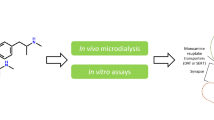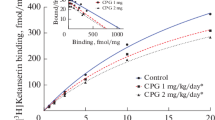Summary
Ex vivo receptor binding experiments and measurements of the concentrations of the amine metabolites HVA, MOPEG-SO4 and 5-HIAA were carried out on rat brain tissues to analyse the effects of several neuroleptics (haloperidol, chlorpromazine, thioridazine, clozapine, fluperlapine), antidepressants (amitriptyline, mianserin, zimelidine) and other drugs (pizotifen, ketanserin, prazosin) on brain aminergic systems. It was found that in all cases where drugs reduced 3H-haloperidol binding to striatal D2-receptors ex vivo (haloperidol, chlorpromazine, thioridazine, clozapine, fluperlapine, pizotifen, zimelidine), the same drugs caused a pronounced increase, in vivo, in the striatal HVA-concentration, i.e. an increase in DA-turnover. The HVA-increase was directly proportional to the extent of the reduction of 3H-haloperidol binding. These findings suggested that in the 3H-haloperidol assay binding of drugs is to functional D2-receptors regulating the release of DA. In contrast, reduction of binding of 3H-prazosin to brain stem α1-receptors ex vivo (all drugs except zimelidine) was only associated with an in vivo increase in the MOPEG-SO4 concentration in some cases (haloperidol, chlorpromazine, thioridazine, clozapine, fluperlapine, ketanserine). Similarly, reduction of 3H-spiperone binding to 5-HT2-receptors in the frontal cortex (all agents except prazosin and zimelidine) was only associated with an increase in the 5-HIAA concentration in certain cases (thioridazine, clozapine, fluperlapine, pizotifen, ketanserin). The present data indicate that in the brain α1- and 5-HT2-receptors do not seem to be linked directly to the processes which govern the turnover of the neurotransmitters DA, NA or 5-HT.
These studies show that the ex vivo receptor binding technique can be useful for measuring the presence of systemically administered drugs in the brain and, particularly when combined with other biochemical measurements, for investigating the role of different transmitter systems in the regulation of physiological processes in the brain.
Similar content being viewed by others
References
Auerbach S, Lipton P (1985) Regulation of serotonin release from the in vitro rat hippocampus: effects of alterations in levels of depolarization and in rates of serotonin metabolism. J Neurochem 44:1116–1130
Burki HR (1978) Correlation between 3H-haloperidol binding in the striatum and brain amine metabolism in the rat after treatment with neuroleptics. Life Sci 23:437–442
Burki HR, Asper H, Ruch W, Zuger PE (1978) Bromocriptine, dihydroergotoxine, methysergide, d-LSD, CF 25-397, and 29–712: effects on the metabolism of the biogenic amines in the brain of the rat. Psychopharmacology 57:227–237
Burki HR, Asper H, Zimmermann U (1982) Application of ex vivo radioreceptor assays in the analysis of neuroleptic drug action. In: Theoretical problems of modern psychiatry. International symposium, Moscow, Proceedings, 105–113
Burt DR, Creese I, Snyder SH (1976) Properties of 3H-haloperidol and 3H-dopamine binding associated with dopamine receptors in calf brain membranes. Mol Pharmacol 12:800–812
Clements-Jewery S, Robson PA (1980) The in vivo and in vitro occupation of 3H-spiperone binding sites in the frontal cortex and striatum by putative 5-hydroxytryptamine antagonists. Neuropharmacol 19:657–661
Closse A, Frick W, Dravid A, Bolliger G, Hauser D, Sauter A, Tobler HJ (1984) Classification of drugs according to receptor binding profiles. Naunyn-Schmiedeberg's Arch Pharmacol 327:95–101
Giacalone E, Valzelli L (1969) A spectrofluorimetric method for the simultaneous determination of 2-(5-hydroxyindol-3-yl) ethylamine (serotonin) and 5-hydroxyindol-3-yl-acetic acid in the brain. Pharmacology 2:171–175
Goethert M, Schlicker E (1983) Autoreceptor-mediated inhibition of 3H-5-hydroxytryptamine release from rat brain cortex slices by analogues of 5-hydroxytryptamine. Life Sci 32:1183–1191
Heepe P, Starke K (1985) α-Adrenoceptor antagonists and the release of noradrenaline in rabbit cerebral cortex slices: support for the α-autoreceptor hypothesis. Br J Pharmacol 84:147–155
Janssen PAJ (1982) 5-HT2 receptor blockade to study serotonin-induced pathology. In: Theoretical problems of modern psychiatry. International symposium, Moscow, Proceedings, 121–132
Kleinlogel H, Burki HR (1984) Correlations between drug-induced changes in rat sleep EEG and interactions with D2-, 5-HT2-and α1-adrenoceptors. Abstract 7. European Sleep Research Society, Congress, Munich.
Laduron PM, Leysen JE (1979) Domperidon, a specific in vitro dopamine antagonist, devoid of in vivo central dopaminergic activity. Biochem Pharmacol 28:2161–2165
Langer SZ (1981) Presynaptic regulation of the release of catecholamines. Pharma Rev 32:337–362
Leysen JE, Gommeren W, Laduron PM (1978) Spiperone: a ligand of choice for neuroleptic receptors. Biochem Pharmacol 27:307–316
Meek JL, Neff NH (1972) Fluorimetric estimation of 4-hydroxy-3-methoxyphenyl-ethyleneglycol sulphate in brain. Br J Pharmacol 45:435–441
Mobley P, Greengard P (1985) Evidence for widespread effects of noradrenaline on axon terminals in the rat frontal cortex. Proc Natl Acad Sci USA 82:945–947
Pazos A, Hoyer D, Palacios JM (1985) Mesulergine, a selective serotonin-2 ligand in the rat cortex, does not label these receptors in porcine and human cortex: evidence for species differences in brain serotonin-2 receptors. Eur J Pharmacol 106:531–538
Starke K (1977) Regulation of noradrenaline release by presynaptic receptor systems. Rev Physiol Biochem Pharmacol 77:1–124
Supavilai P, Karobath M (1984) The interaction of [3H] 108-068 and of [3H] PN 200-110 with calcium channel binding sites in rat brain. J Neural Transm 60:149–167
Tang SW, Seeman P (1980) Effect of antidepressant drugs on serotonergic and adrenergic receptors. Naunyn-Schmiedeberg's Arch Pharmacol 311:255–261
Verbeuren TJ, Coen EP, Schoups A, Van de Velde R, Bayens R, De Potter WP (1984) Presynaptic serotonin receptors regulate the release of 3H-serotonin in hypothalamic slices of the rabbit. Naunyn-Schmiedeberg's Arch Pharmacol 327:102–106
Westerink BHC (1977) Regional dopamine metabolism in the rat brain. Doctoral Thesis, University of Groningen
Author information
Authors and Affiliations
Rights and permissions
About this article
Cite this article
Burki, H.R. Binding of psychoactive drugs to rat brain amine receptors, measured ex vivo, and their effects on the metabolism of biogenic amines. Naunyn-Schmiedeberg's Arch. Pharmacol. 332, 258–266 (1986). https://doi.org/10.1007/BF00504864
Received:
Accepted:
Issue Date:
DOI: https://doi.org/10.1007/BF00504864




